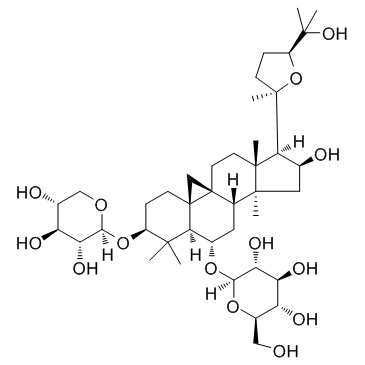84687-43-4
| Name | Astragaloside IV |
|---|---|
| Synonyms |
Astragalus Polysaccharides
(3β,6α,9β,16β,20R,24S)-16,25-Dihydroxy-3-(β-D-xylopyranosyloxy)-20,24-epoxy-9,19-cyclolanostan-6-yl β-D-glucopyranoside ASTRAGALOSIDE Astrasieversianin XIV Astragalus extract Astragaloside IV β-D-Glucopyranoside, (3β,6α,9β,16β,20R,24S)-20,24-epoxy-16,25-dihydroxy-3-(β-D-xylopyranosyloxy)-9,19-cyclolanostan-6-yl cyclosieversioside F cyclosiversioside F MFCD07368617 |
| Description | Astragaloside IV, an active component isolated from Astragalus membranaceus, suppresses the activation of ERK1/2 and JNK, and downregulates matrix metalloproteases (MMP)-2, (MMP)-9 in MDA-MB-231 breast cancer cells. |
|---|---|
| Related Catalog | |
| Target |
MMP-2 MMP-9 ERK1 ERK2 JNK |
| In Vitro | Astragaloside IV (10, 20, 40 ng/mL) inhibits NSCLC cell growth, whereas low concentrations of astragaloside IV (1, 2.5, 5 ng/mL) has no obvious cytotoxicity on cell viability. Moreover, combined treatment with astragaloside IV significantly increases chemosensitivity to cisplatin in NSCLC cells. On the molecular level, astragaloside IV co-treatment significantly inhibits the mRNA and protein levels of B7-H3 in the presence of cisplatin[2]. Astragaloside IV inhibits the viability and invasive potential of MDA-MB-231 breast cancer cells, suppresses the activation of the mitogen activated protein kinase (MAPK) family members ERK1/2 and JNK, and downregulates matrix metalloproteases (MMP)-2 and -9[4]. |
| In Vivo | Astragaloside IV (10, 20 mg/kg, p.o.) exhibits a potent ability to prevent cognitive deficits induced by transient cerebral ischemia and reperfusion. Astragaloside IV (10 mg/kg) and Astragaloside IV (20 mg/kg) can significantly decrease the levels of these cytokines compared to the Model group. Astragaloside IV significantly inhibits the level of TLR4 and its downstream proteins, suggesting that both MyD88-dependent and -independent pathways play important roles in the anti-inflammatory effects of Astragaloside IV. Astragaloside IV attenuates NLRP3 and cleaved-caspase-1 expression, and reduces Iba1 protein expression[1]. In the mice model, the high-dose astragaloside IV group has a significant increase in the 48-hour survival rate [60% (9/15) vs 13.3% (2/15), P < 0.05], significant reductions in the serum ALT and AST levels (P < 0.01), and significant reductions in liver histopathological indices and the degree of apoptosis of hepatocytes (P < 0.01), as well as a significant reduction in the content of MDA in liver homogenate (P < 0.01) and a significant increase in the activity of SOD[3]. |
| Kinase Assay | Briefly, MDA-MB-231 cells treated as indicated or tumor tissues are harvested and lysed in Mg2+ lysis buffer containing 50 mM Tris (pH 7.5), 10 mM MgCl2, 0.5 M NaCl, and protease inhibitor cocktail. Equal amounts of lysates are incubated with PAK-PBD beads at 4°C for 1 h. PAK-PBD beads are pelleted by centrifugation and washed with ish buffer containing 25 mM Tris (pH 7.5), 30 mM MgCl2, 40 mM NaCl. Active Rac1 is detected by western blotting. |
| Cell Assay | Cell viability is determined by CCK-8 assay. To be brief, cultured NSCLC cells are seeded into 96-well plates at the density of 4×104 (cells/well). Then 10 µL⁄well CCK8 solution is added and incubated in dark at 37°C for another 2 h. The absorbance is determined with the wavelength of 490 nm. |
| Animal Admin | Transient cerebral ischemia and reperfusion is prepared by BCCAO, as BCCAO is considered an ideal model to study transient cerebral ischemia and reperfusion injury-mediated inflammatory response. Mice are randomLy divided into the Sham, Model, Astragaloside IV (10 mg/kg) and Astragaloside IV (20 mg/kg) treatment groups. The Astragaloside IV treatment groups are intragastrically administered 7 days before the surgery and terminated on the day of sacrifice. On the day of the surgery, Astragaloside IV is administrated 2 h prior to ischemia. The Sham-operated and Model groups are treated with distilled water. After the mice are anesthetized with an intraperitoneal injection of chloral hydrate (350 mg/kg), the bilateral common carotid arteries are exposed and carefully separated with a small ventral neck incision and occluded twice (20 min each) with ligated surgical silk as described previously with minor modifications. There is a 10 min reperfusion period between the two occlusion periods (ischemia 20 min − reperfusion 10 min − ischemia 20 min). Sham-operated mice are subjected to the same surgical operation without the surgical silk ligation. Mouse body temperature is maintained at 37±0.5°C during the surgery with heating equipment until recovery from the anesthesia. |
| References |
| Density | 1.4±0.1 g/cm3 |
|---|---|
| Boiling Point | 895.7±65.0 °C at 760 mmHg |
| Melting Point | 295-296ºC |
| Molecular Formula | C41H68O14 |
| Molecular Weight | 784.970 |
| Flash Point | 495.5±34.3 °C |
| Exact Mass | 784.460938 |
| PSA | 228.22000 |
| LogP | 1.96 |
| Vapour Pressure | 0.0±0.6 mmHg at 25°C |
| Index of Refraction | 1.621 |
| Personal Protective Equipment | Eyeshields;Gloves;type N95 (US);type P1 (EN143) respirator filter |
|---|---|
| Safety Phrases | S22-S24/25 |
| RIDADR | NONH for all modes of transport |
| HS Code | 2932999099 |
| HS Code | 2932999099 |
|---|---|
| Summary | 2932999099. other heterocyclic compounds with oxygen hetero-atom(s) only. VAT:17.0%. Tax rebate rate:13.0%. . MFN tariff:6.5%. General tariff:20.0% |


